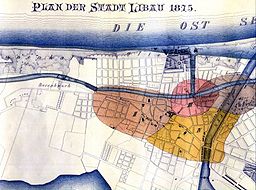Līva (river)
| Līva | |
| — Lyva — | |
| River | |
|
Probable place where Līva was located
|
|
| Nickname: Liv | |
| Country | Latvia |
|---|---|
| District | Liepāja |
| Source | Liepāja Lake |
| - coordinates | 56°28′59″N 21°01′00″E / 56.483°N 21.0167°E |
| Mouth | Baltic Sea |
| - coordinates | 56°31′00″N 20°59′00″E / 56.5167°N 20.9833°ECoordinates: 56°31′00″N 20°59′00″E / 56.5167°N 20.9833°E |
Līva (German: Lyva, Lyua, Libau) was a famous river in Kurzeme in today's Latvia. It was located between the Baltic Sea and Liepāja Lake and had a length of about 6 kilometres and a width near the mouth of about 50 metres. The source of the Līva was located in Liepāja Lake near the former Pērkone river. The place where the Līva fell into the Baltic Sea was located approximately at the site of today's northern harbour in Liepāja. The river had one known island, Perkunen (Latvian: Pērkona galva); it was located near the source of the river. The Līva served as a water trade way to Grobiņa via the Liepāja lake and the port was located on it. The original suburb with a name Līva was located about 1 kilometre from the mouth of the river on both sides of it. The old name for the city Liepāja descends from the name of the river and for the centuries was associated with it. The part of the river near the mouth had become too shallow by the end of the 15th century. In the 16th century, the first Līva channel was dug up between Līva and Baltic Sea with a length of about 780 metres and a width of 50 metres. In 1697–1703, the new Trade channel was dug up and few years later the river was filled up.
The German name Lyva (Latvian: Līva) derived from Livonian language liiv — sand. The other sources offer alternative etymology for the name, Liva is the old name of Liepāja Lake or a derivative from the Mari language lya (lyva) — sand shore, sand spit. The name is also very similar to the German word for the love — liebe.
The territory of the present day Latvia was cleared from the ice in about 8000 BC, in the same period the river was formed. The territory near the river, on the present territory of Liepāja was populated by the Baltic-Slavic Venedi tribes (West-Baltic barrow culture) from the 1st millennium BC. Līva was not mentioned by the Ptolemy among the rivers of Latvia known to Romans – Rudon, Turuntes and Chesinos. Later, after the 5th century the territory near the Liepāja Lake was inhabited by the Curonians (Letts) and was Danish colony. The first known source mentioning people visited neighborhood of the river are found in Rimbert's Vita Ansgari when the Olof (I) of Sweden begin a war with the Curonians in 856 AD, after the war the territory come to the control of Swedes. The name Līva for the first time was mentioned in 1263. In 1424 year the river was described by the French knight Guillebert de Lannoy. In 1581 Prussian land surveyor Athier Wrenfoldt drew up the first map where the river Līva was shown.
...
Wikipedia

